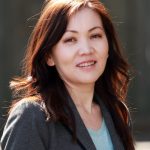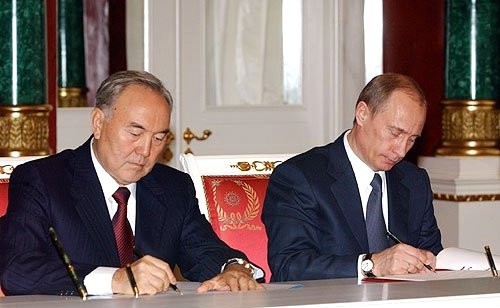Author

Aigoul Abdoubaetova researches the growing gap in educational opportunities in Kyrgyzstan. She is Programme Manager of the MA in Politics and Security at the OSCE Academy in Bishkek, Kyrgyzstan, and has over nine years of professional experience working in higher education administration. Previously, Aigoul worked for a number of non-profit organizations specializing in the areas of youth, international adoption, and other social issues. She holds an MA in International Studies from the University of Oregon and a BA in Foreign Languages from Osh State University.e after 1991.
Overview of Secondary Education Opportunities in Bishkek
As of 2018, Kyrgyzstan’s GDP per capita was reported to be $1,221.[1] Yet annual tuition at the most expensive top four private schools in the country ranges between $11,000[2] and $23,800.[3] These numbers are indicative of growing inequality in accessing and obtaining secondary education in Bishkek, the capital of Kyrgyzstan.
Over the past two decades, secondary educational opportunities in Bishkek have become more diversified, due both to the growing number and variety of private schools and the division of public schools into different categories depending on the quality of education they offer.
As of 2017, there were 114 private schools in Kyrgyzstan, and there may now be as many as 187.[4] Private schools are very heterogeneous, with a diverse mix of prices and services.[5] Many of them have excellent infrastructure and facilities, small class sizes, and better-paid teachers.


Source: “Gid Kaktus. Chastnye shkoly Bishkeka. Usloviia i tseny,” Kaktus Media, May 25, 2018
The boom in private education is occurring in the context of acute shortages and the deteriorating quality of public schools. Public schools face myriad issues,[6] including extreme overcrowding due to internal migration that has caused the population of Bishkek to expand.

Yet the outlook for public schools is not altogether bleak. There are a few high-performing “elite” public schools (gymnasiums and lyceums) that achieve top results on the NST,[7] a national merit-based selection system that tests the knowledge and skills of secondary school graduates applying for government scholarships to local universities.[8] High-performing elite public schools are seen as prestigious and are difficult to get into.
Through my own research and drawing on publicly available information, I identify six types of secondary education opportunities in Bishkek: three types of private schools based on their tuition costs and two types of public schools based on their performance. A sixth option, private tutors and learning centers, is also widely used to obtain additional secondary education.
 Elite international private schools:
Elite international private schools:
a. Tuition—$10-25,000
b. Preparing students “for export”: international accreditation, all subjects taught in English
c. International teachers, excellent facilities, security, small class sizes, student-friendly atmosphere

a. Tuition—$3-5,000
b. Excellent prospects of entering top universities in Kyrgyzstan
c. Qualified and decently paid teachers, good facilities, security, small class sizes, student-friendly atmosphere

a. Tuition—under $3,000
b. Financial (not always merit-based) opportunities for entering good universities
c. Select teachers, decent facilities, security, small class sizes, student-friendly atmosphere
 High-performing public schools:
High-performing public schools:
a. Free; collection of fees from parents for school needs—$100-200 per year (estimated average)
b. Merit-based opportunities to enter good universities
c. Select teachers, average facilities, no security, large class sizes, harsh discipline, selective admission

a. Free; collection of fees from parents for school needs—$50-80 a year (estimated average)
b. Limited prospects (both merit-based and financial) of entering good universities
c. Underpaid teachers with heavy loads, average or poor facilities, no security, large class sizes

a. $2-4 per hour or $80-150 per month to attend group sessions (3-4 times a week)
b. Flexible schedules and payment schemes; targeted choice of subjects
My paper sought to answer the following specific questions:
1) How do parents in Bishkek make school choices and navigate the fragmented landscape of the secondary education system?
2) To what degree do parents’ educational choices reflect and reinforce growing socio-economic inequality in a society that is undergoing significant transformations
My research employed quantitative and qualitative methods. The main group of informants were parents of schoolchildren aged 7-17 who attend public and private schools in Bishkek. 115 parents were surveyed for a questionnaire and a further 22 in-depth interviews with parents and 13 interviews with experts were conducted. This summary of findings is structured around two main themes: parents’ motivations for choosing private or public schools for their children and discussion of inequality in children’s access to education.
Parents’ Motivations for Choosing Private Schools
The survey results showed that parents chose private schools to access a wide range of privileges:
Parents selected private schools because of their small class sizes, more individualized teacher-student interaction, and less conservative teaching methods.
Most private schools in Bishkek provide all-day child care services: they organize meals, after-school activities, and homework help on the school premises. Parents are interested in such conveniences.
Expensive international private schools appeal to parents because of their focus on English. Having native English speakers as teachers, an international curriculum taught only in English, and in-house college counselors helps students get into universities abroad.
Turkish private schools in Bishkek that belong to the Sapat International Education Institution attract parents by providing a good quality of education as well as instilling moral values such as respect for parents and the elderly, tolerance, compassion, altruism, brotherhood/sisterhood, etc.
Parents’ Motivations for Choosing Public Schools
The survey results revealed a completely different picture of parental motivations for choosing public schools. Location-related reasons were the most important factor for the majority of parents:
Parents chose public schools because of these schools’ proximity. Parents who sent their children to public schools were divided between those who used neighborhood schools (assigned by territory) and those who bypassed this system in search of better-quality schools while still focusing on those schools that were not too far from their homes.
Parents only chose public schools for their education quality in the case of high-performing schools. They found qualified teachers, specialized curriculum, discipline, and high NST scores to be important factors in choosing these schools. Those who sent their children to low-performing neighborhood schools, meanwhile, were not satisfied with the quality of teaching.
Attending public schools generally takes only half a day, leaving ample flexible afterschool time to be used for extra-curricular activities, music schools, or attending private tutoring.
Some parents find that public schools better prepare children for real life. Public schools allow children to socialize with other children from diverse backgrounds, become more independent, and gain stronger life skills.
Portrait of Educational Inequality in Bishkek
Parents with higher incomes can afford private schools, while public school users are those who have average incomes or are poor.
Children in private schools are not limited by distance: their parents can take them across the city in their own cars or pay fees for transportation organized by schools. Mobility is connected to income.
Parents of private school children access privileges that are not available in public schools: small classes with proper conditions, a good diet, and better treatment of children by teachers and staff.
The quality of education in private schools was rated higher (68 percent) than in public schools (33 percent). Parents from private schools were more satisfied—4.29 out of 5, compared to 3.74 out of 5 for parents of children in public schools.
There is a noticeable gap between the two types of schools in terms of the future plans that parents envisioned for their children. Eighty-one percent of parents of private school children indicated that their child would study abroad, compared to 20 percent of parents of public school children.
There is also a very strong positive correlation between future university plans abroad and income. Those who have high incomes have more opportunities both for private education and for education abroad, while those who lack money have fewer.
While there is a straightforward correlation between income and school choice, the paper suggests looking at educational inequality through other lenses in addition to the economic one. In order to understand education inequality, it is necessary to consider different forms of capital that families utilize: financial, but also social and cultural.
Parents with wider social capital could access more educational opportunities. Social networks helped parents to figure out which were the good schools and find qualified teachers and tutors.
Cultural capital—the knowledge of how institutions work—helped parents to make strategic decisions, such as preparing children ahead of time for admission to a competitive school; taking advantage of various extracurricular activities; seeking out additional learning opportunities through private tutors; and being actively engaged in their children’s education, constantly motivating and directing them. Parents’ education (human capital) also helped. It is those families that do not possess any of these capitals that are the most disadvantaged.
The structuring of families into a pyramid according to their possession of these three forms of capital helps us better visualize and understand how education inequality in contemporary Bishkek is being shaped.
While wealthy families in the “elite” and “new Kyrgyz” categories chose private schools, many middle-income urban families primarily accessed high-performing and competitive public schools. Poor urban families and internal migrants lacked both financial and non-financial resources: disadvantaged in accessing not only private schools, but also high-quality public schools, they mostly attended low-performing neighborhood schools.
Unfortunately, poor families in the bottom two categories make up the majority of the urban population of Bishkek. Policymakers should prioritize the needs of low-performing schools and increase poor families’ access to quality education.
[1]“The Poorest Countries in the World,” Focus Economics (blog), last accessed September 2, 2018, https://www.focus-economics.com/blog/the-poorest-countries-in-the-world.
[2] “Gid Kaktus. Chastnye shkoly Bishkeka. Usloviia i tseny,” Kaktus Media, May 25, 2018, last accessed October 11, 2018, https://kaktus.media/doc/338956_gid_kaktus._chastnye_shkoly_bishkeka._ysloviia_i_ceny.html.
[3] Z. Kozhobaeva, “Stoit li ucheba v chastnykh shkolakh zaplachennykh deneg?” Azzatyk, February 6, 2017, last accessed October 11, 2018, https://rus.azattyk.org/a/28281350.html.
[4] Kozhobaeva, “Stoit li ucheba.”
[5] Kaktus Media, “Gid Kaktus.”
[6] Sanzhar Eraliev, “Skol’noe obrazovanie. Problemy dostigli krainei tochki,” Azzatyk, September 6, 2018, last accessed November 21, 2018, https://rus.azattyk.org/a/kyrgyz_education_school-problems/29474742.html.
[7] “Reiting. Top 20 shkol Bishkeka 2018 goda,” Bilim Akipress, August 24, 2018, last accessed November 21, 2018, http://bilim.akipress.org/ru/news:1466310.
[8] Duishon Shamatov, “The Impact of Standardized Testing on University Entrance Issues in Kyrgyzstan,” European Education 44, no. 1 (2012): 71-92.




 Elite international private schools:
Elite international private schools: High-performing public schools:
High-performing public schools:








